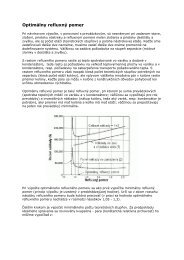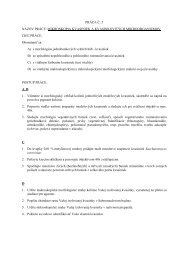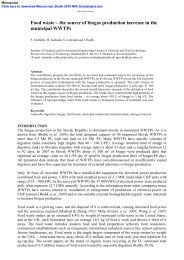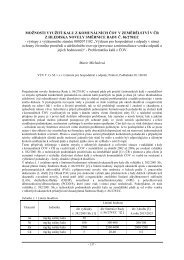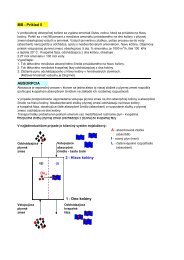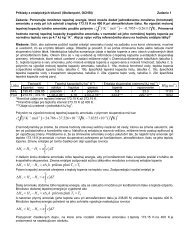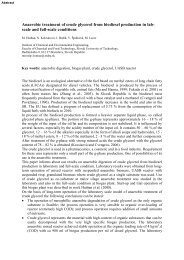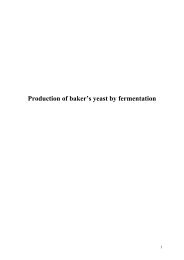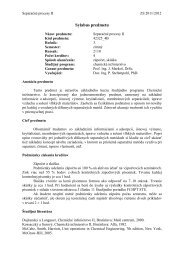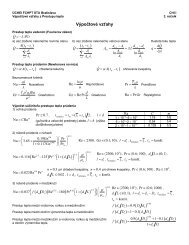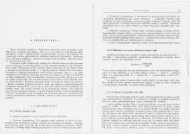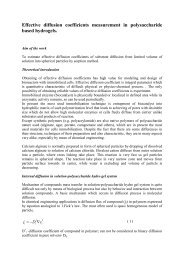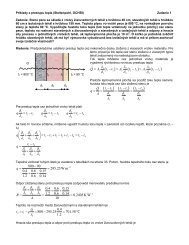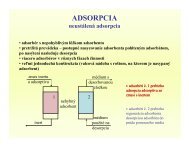The using of enzymes for degradation of cellulose substrate for the ...
The using of enzymes for degradation of cellulose substrate for the ...
The using of enzymes for degradation of cellulose substrate for the ...
You also want an ePaper? Increase the reach of your titles
YUMPU automatically turns print PDFs into web optimized ePapers that Google loves.
Slovak Society <strong>of</strong> Chemical EngineeringInstitute <strong>of</strong> Chemical and Environmental EngineeringSlovak University <strong>of</strong> Technology in BratislavaPROCEEDINGS37 th International Conference <strong>of</strong> Slovak Society <strong>of</strong> Chemical EngineeringHotel HutníkTatranské Matliare, SlovakiaMay 24 – 28, 2010Editor: J. MarkošISBN 978-80-227-3290-1Mackul’ak, T., Prousek, J., Olejníková, P., Bodík, I.: <strong>The</strong> <strong>using</strong> <strong>of</strong> <strong>enzymes</strong> <strong>for</strong> <strong>degradation</strong> <strong>of</strong> <strong>cellulose</strong> <strong>substrate</strong><strong>for</strong> <strong>the</strong> production <strong>of</strong> biogas, Editor: Markoš, J., In Proceedings <strong>of</strong> <strong>the</strong> 37th International Conference<strong>of</strong> Slovak Society <strong>of</strong> Chemical Engineering, Tatranské Matliare, Slovakia, 1407–1412, 2010.
37th International Conference <strong>of</strong> SSCHEMay 24–28, 2010, Tatranské Matliare, SlovakiaPo-Th-6, 116p.pdf<strong>The</strong> Using Of Enzymes For Degradation Of Cellulose Substrate For <strong>The</strong>Production Of BiogasTomáš Mackuľak, Josef Prousek, Petra Olejníková a , Igor Bodík,Department <strong>of</strong> Environmental Engineering, Institute <strong>of</strong> Chemical and Environmental Engineering,Faculty <strong>of</strong> Chemical and Food Technology, Slovak University <strong>of</strong> Technology, Radlinskeho 9, 812 37Bratislava, Slovak RepublicaDepartment <strong>of</strong> Biochemistry and Microbiology, Institute <strong>of</strong> Biochemistry, Nutrition and HealthProtection, Faculty <strong>of</strong> Chemical and Food Technology, Slovak University <strong>of</strong> Technology, Radlinskeho9, Bratislava 812 37, Slovak Republic,e-mail: mackulakt@azet.skKey wordsenzymatic hydrolysis, <strong>cellulose</strong> <strong>substrate</strong>, glucoseAbstract<strong>The</strong> main purpose <strong>of</strong> this article is to describe different kinds <strong>of</strong> <strong>cellulose</strong> <strong>degradation</strong> processes such asenzymatic hydrolysis. As <strong>the</strong> <strong>cellulose</strong> <strong>substrate</strong>s <strong>the</strong> sawdust, leaves and cartons were used. Anaerobic<strong>degradation</strong> processes utilized <strong>for</strong> <strong>the</strong> biogas production can be accelerated by this way.1. IntroductionAs <strong>substrate</strong>s <strong>for</strong> biogas production waste materials which contain polysaccharides, lipids and proteinscan be used. Plant origin <strong>substrate</strong>s contain mainly <strong>cellulose</strong> (Fig. 1), hemi<strong>cellulose</strong> and lignin [1]. <strong>The</strong>structure <strong>of</strong> <strong>cellulose</strong> consists <strong>of</strong> parallel glucan chains and is stabilized by hydrogen bonds.Fig. 1. Cellulose structure<strong>The</strong> main structural unit <strong>of</strong> <strong>cellulose</strong> is D – glucose [3]. Cellulose is resistant to different types <strong>of</strong><strong>degradation</strong> [2]. <strong>The</strong> <strong>cellulose</strong> <strong>substrate</strong> contains various representation <strong>of</strong> lignin, which influences <strong>the</strong>resistance <strong>of</strong> <strong>substrate</strong> and also increases <strong>the</strong> cost <strong>of</strong> pretreatment. Usage <strong>of</strong> hay, straw and recycledpaper as a <strong>substrate</strong> containing ligno<strong>cellulose</strong>s <strong>for</strong> increasing biogas production is currently beingtested and interesting topic.A mechanical pretreatment is <strong>the</strong> first step in <strong>the</strong> pretreatment <strong>of</strong> ligno<strong>cellulose</strong>s <strong>substrate</strong>. In next stepsis possible to degrade <strong>cellulose</strong> by chemical or enzymatic hydrolysis [5, 8]. <strong>The</strong> chemical hydrolysis byH 2 SO 4 and HCl leads to breaking <strong>cellulose</strong> into cellotetrose and cellobiose [2, 4, 8]. By Fenton reactionis possible to degrade cellotetrose and cellobiose to glucose, a simple aldehydes and ketones. Directway to degrade <strong>cellulose</strong> into glucose is enzymatic hydrolysis.Enzymatic hydrolysis <strong>of</strong> <strong>cellulose</strong> takes place with a mixture <strong>of</strong> <strong>enzymes</strong> – cellulases [1, 5-9], at 36 –37 °C. Cellulases break down <strong>cellulose</strong> in three ways. Endoglucanases convert chains <strong>of</strong> <strong>cellulose</strong> from1407
37th International Conference <strong>of</strong> SSCHEMay 24–28, 2010, Tatranské Matliare, SlovakiaPo-Th-6, 116p.pdf<strong>the</strong> inside, creating new ends <strong>of</strong> shorter chains [1]. Exoglucanases separated from non-reducting ends<strong>of</strong> new chains cellobiotic units. In consequent steps cellotetrose and cellobiose are decomposed toglucose in liquid phase by <strong>the</strong> enzyme β-glucosidase [1]. Cellulases are produced by different types <strong>of</strong>bacteria and filamentous fungi [5,7]. Research <strong>of</strong> different tribes <strong>of</strong> filamentous fungi isolated fromwaste waters from paper production, which are able to produce <strong>cellulose</strong> in large scale seems to beinteresting nowadays [5,7]. Lignocellullase <strong>substrate</strong> pre-treated in this way can be used to increase <strong>the</strong>quality and quantity <strong>of</strong> produced biogas.2. Experimental partCellulose <strong>substrate</strong>Cellulose <strong>substrate</strong> was inactivated with lime (Fig. 2). Total solids were 43% and volatile solids were44%.Fig. 2. Cellulose <strong>substrate</strong>Principes <strong>of</strong> glucose determinationOxidation <strong>of</strong> glucose with oxygen was pre<strong>for</strong>med with enzymatic catalysis by glucose oxidase <strong>for</strong>hydrogen peroxide and gluconate. Formed hydrogen peroxide was determinated by oxidationcopulation with substitued phenol and 4- aminoantipyrine and cotalised with peroxidase.Determination <strong>of</strong> glucoseOperating solution was mixed with serum or sample, standard glucose solution and distilled water(control solution) in <strong>the</strong> ratio 100:1 or 150:1 in three tubes. Incubation was pre<strong>for</strong>med <strong>for</strong> 30 min. at15- 25 °C or <strong>for</strong> 15 min. at 37°C. <strong>The</strong> incubation mixture must be protected from direct light. Whitin40 min. after incubation <strong>the</strong> absorbance <strong>of</strong> sample (A 1 ) and absorbance <strong>of</strong> sample (A 2 ) was measuredand compared with control solution.CalculationGlucose (mmol.l -1 ) = a. A 1 /A 2 ,where a is glucose contentration in standard solution [mmol.l -1 ].Enzymatic hydrolysisIn various experiments with <strong>enzymes</strong> different amounts <strong>of</strong> enzyme mixture <strong>for</strong> <strong>cellulose</strong> <strong>substrate</strong><strong>degradation</strong> were used (Fig. 3). <strong>The</strong> effectiveness <strong>of</strong> individual experiments on <strong>the</strong> measurement <strong>of</strong>COD value (mg.l -1 ) and glucose concentration was determined (g.l -1 ). Procedures and results in<strong>degradation</strong> <strong>of</strong> <strong>the</strong> <strong>substrate</strong> are given in experiments No. 1-3, and Fig. 4-5.1408
37th International Conference <strong>of</strong> SSCHEMay 24–28, 2010, Tatranské Matliare, SlovakiaPo-Th-6, 116p.pdfFig. 3. Enzymatic hydrolysisExperiment No. 1 (E1)In <strong>the</strong> first series <strong>of</strong> experiments with compound <strong>of</strong> <strong>enzymes</strong> 5mg <strong>of</strong> <strong>enzymes</strong> were added into 200 ml<strong>of</strong> deionized water. <strong>The</strong> solution was stirred until dissolved <strong>enzymes</strong>. In <strong>the</strong> next step 3 g <strong>of</strong> <strong>cellulose</strong><strong>substrate</strong> were added. <strong>The</strong> temperature was 37°C and mixture wasn’t stirred. Degradation <strong>of</strong> <strong>substrate</strong>to glucose was determined by glucose- oxidation test and by measurement <strong>of</strong> COD values.Experiment No. 2 (E2)In ano<strong>the</strong>r series <strong>of</strong> experiments 50 mg <strong>of</strong> compound <strong>of</strong> <strong>enzymes</strong> were dissolved in 200 ml <strong>of</strong> deionizedwater. <strong>The</strong> solution was stirred until dissolved <strong>enzymes</strong>. In <strong>the</strong> next step 3 g <strong>of</strong> <strong>cellulose</strong> <strong>substrate</strong> wereadded. <strong>The</strong> temperature was 37°C and mixture wasn’t stirred. Degradation <strong>of</strong> <strong>substrate</strong> to glucose wasdetermined by glucose- oxidation test and by measurement <strong>of</strong> COD values.Experiment No. 3 (E3)In final series <strong>of</strong> experiments with compound <strong>of</strong> <strong>enzymes</strong> 450 mg <strong>of</strong> <strong>enzymes</strong> were dissolved in 200 ml<strong>of</strong> deionized water. <strong>The</strong> solution was stirred until dissolved <strong>enzymes</strong>. In <strong>the</strong> next step 3 g <strong>of</strong> <strong>cellulose</strong><strong>substrate</strong> were added. <strong>The</strong> temperature was 37°C and mixture wasn’t stirred. Degradation <strong>of</strong> <strong>substrate</strong>to glucose was determined by glucose- oxidation test and measurement <strong>of</strong> COD values.3. Results and discussionEnzymatic hydrolysis decomposes <strong>cellulose</strong> to cellotetrose and cellobiose in first step. Subsequentlycellotetrose and cellobiose are degradated to glucose, lower aldehydes and ketones (Fig. 4). Products <strong>of</strong>enzymatic hydrolysis depends on <strong>the</strong> type and composition <strong>of</strong> <strong>the</strong> <strong>substrate</strong>, <strong>the</strong> reaction time, <strong>the</strong> typeand quantity <strong>of</strong> <strong>the</strong> <strong>enzymes</strong> and <strong>the</strong> reaction temperature. Glucose itself can be enzymatic degraded toaldehydes and ketones.Compound <strong>of</strong> <strong>enzymes</strong> was used <strong>for</strong> <strong>the</strong> <strong>degradation</strong> <strong>of</strong> cellulosic <strong>substrate</strong>. Time dependence <strong>of</strong>glucose production resulting from <strong>substrate</strong> <strong>degradation</strong> is shown in figure 5. From each experiment isappeared that <strong>the</strong> production <strong>of</strong> glucose is affected by <strong>the</strong> amount <strong>of</strong> <strong>enzymes</strong> used, quantity <strong>of</strong><strong>substrate</strong>, reaction temperature and time. <strong>The</strong> highest glucose yield was achieved in <strong>the</strong> experiments no.3. In experiment No. 2 and 3. a decrease in glucose concentration after 24 hrs. was observed, whichwas caused by <strong>the</strong> amount <strong>of</strong> used <strong>enzymes</strong> (Tab. 1, Fig. 4).1409
37th International Conference <strong>of</strong> SSCHEMay 24–28, 2010, Tatranské Matliare, SlovakiaPo-Th-6, 116p.pdfFig. 4. Expected mechanism <strong>of</strong> <strong>cellulose</strong> <strong>degradation</strong> by enzymatic hydrolysis0,350,300,25glucose g.l -10,200,150,10E 1E 2E 30,050,000 10 20 30 40 50 60 70 80t(h)Fig. 5. Time dependance <strong>of</strong> glucose production by enzymatic <strong>degradation</strong> <strong>of</strong> <strong>cellulose</strong> <strong>substrate</strong>.Tab. 1. Time dependance <strong>of</strong> glucose production by enzymatic <strong>degradation</strong> <strong>of</strong> <strong>cellulose</strong> <strong>substrate</strong> inexperiments no. 1-3.Time (hours) Glucose (g.l -1 )E 1 E 2 E 36 0.1 0.2 0.2224 0.2 0.26 0.3248 0.22 0.3 0.2872 0.26 0.26 0.241410
37th International Conference <strong>of</strong> SSCHEMay 24–28, 2010, Tatranské Matliare, SlovakiaPo-Th-6, 116p.pdfTab. 2. Time dependence <strong>of</strong> COD value in experiments no. 1- 3 <strong>of</strong> glucose production by enzymatic<strong>degradation</strong> <strong>of</strong> <strong>cellulose</strong> <strong>substrate</strong>.Time (hours) COD (mg.l -1 )E 1 E 2 E 36 200 250 34024 360 540 59048 430 580 62072 600 650 6807 0 06 0 05 0 0CHSK (mg.l -1 )4 0 03 0 02 0 0E 1E 2E 31 0 000 1 0 2 0 3 0 4 0 5 0 6 0 7 0 8 0t ( h )Fig. 6. Comparation <strong>of</strong> experiments no. 1-3 by COD value.4. ConclusionFrom results it can be concluded that lignocellulosic <strong>substrate</strong>s can be succesfully modified byenzymatic hydrolysis. We dealt with <strong>the</strong> use <strong>of</strong> enzymatic hydrolysis in experiments No. 1-3. It isobtained possible to decompose <strong>cellulose</strong> <strong>substrate</strong> to glucose by <strong>enzymes</strong>. Yield <strong>of</strong> glucose is dependson quantity <strong>of</strong> <strong>substrate</strong> used, amount <strong>of</strong> used <strong>enzymes</strong> used, reaction temperature and time (Fig. 5).Substrate is decomposed to glucose and lower aldehydes <strong>for</strong> prolonged exposure to <strong>enzymes</strong>.Efficiency and progress <strong>of</strong> enzymatic hydrolysis is affected by content <strong>of</strong> lignin in <strong>substrate</strong>. Celluloseis covered by lignin and <strong>the</strong>reby increase <strong>the</strong> resistance <strong>of</strong> <strong>cellulose</strong> to enzymatic <strong>degradation</strong>. It is<strong>the</strong>re<strong>for</strong>e possible to combine <strong>the</strong> procedures <strong>for</strong> remove lignin (e.g., chemical hydrolysis) andsubsequently enzymatic hydrolysis or microbial <strong>degradation</strong> can be used. <strong>The</strong> effectiveness <strong>of</strong>enzymatic hydrolysis can be regulated or completely inhibited by temperature increasing. Enzymatichydrolysis is one <strong>of</strong> <strong>the</strong> processes by which we can pretreated <strong>cellulose</strong> <strong>substrate</strong>s such as sawdust,leaves, hay, straw, recycled paper and thus accelerated <strong>the</strong> processes <strong>of</strong> <strong>degradation</strong> under anaerobicconditions. Products <strong>of</strong> enzymatic <strong>degradation</strong> <strong>of</strong> <strong>substrate</strong>s are glucose and lower aldehydes, which are1411
37th International Conference <strong>of</strong> SSCHEMay 24–28, 2010, Tatranské Matliare, SlovakiaPo-Th-6, 116p.pdfhighly degraded in anaerobic processes. Substrates treated in this way are easier and fasterbiodegradabiled and can be used to increase biogas yield and quantity.5. References1. Straka F. a kol. (2006).: Bioplyn. Praha: GAS s.r.o.,706 s.2. Görner F., Valík Ľ. (2004).: Aplikovaná mikrobiológia požívatín. Malé Centrum, Bratislava.3. Šulák M., Šmogrovičová D. (2008).: Bioetanol : Súčasné trendy vo výskume a v praxi : Chem.Listy 102, 108−115.4. Sun Y., Cheng J. (2002).: Hydrolysis <strong>of</strong> lignocellulosic materials <strong>for</strong> ethanol production.Bioresource Technology., 83, 1-11.5. Tanaka H., Koike K., Itakura S., Enoki A. (2009).: Degradation <strong>of</strong> wood and enzyme productionby Ceriporiopsis subvermispora. Enzyme Microb. Technol. doi:10.1016/j.enzmictec.2009.06.003.6. Romsaiyud A, Songka S.W., Nopharatana A., Chaiprasert P. (2009).: Combination effect <strong>of</strong> pHand acetate on enzymatic <strong>cellulose</strong> hydrolysis. J. Environ. Sci. 21, 965–970.7. Solange I.M., Marcela F., Adriane M.F.M, Inˆes C.R. (2008).: Effect <strong>of</strong> hemi<strong>cellulose</strong> and ligninon enzymatic hydrolysis <strong>of</strong> <strong>cellulose</strong> from brewer’s spent grain. Enzyme Microb. Technol. 43,124–129.8. Voet D., Voetová J.G. (1995).: Biochemie. Victoria Publishing a.s.,Praha, 268-283.9. Mackuľak T., Prousek J., Bodík I. (2009).: Predúprava a využitie celulózového substrátu z výrobypapiera na produkciu bioplynu. Zborník konferencie: Výstavba a provoz bioplynových stanic.Třeboň, október 15.-16, str. 83-89. ISBN-978-80-254-5455-8.Acknowledgements<strong>The</strong> presented contributions was created as a part <strong>of</strong> project SK00023 financed by Norwegian FinancialMechanism, Financial Mechanism <strong>of</strong> EEA and <strong>the</strong> State Budget <strong>of</strong> <strong>the</strong> Slovak Republic(www.eeagrants.com). This work was supported by <strong>the</strong> Slovak Research and Development Agencyunder <strong>the</strong> contract No. LPP-0019-09.1412



